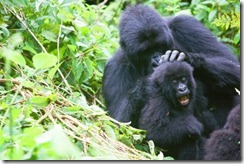The Ministry of Tourism, Wildlife and Antiquities together with Uganda Wildlife Authority (UWA) are pleased to announce a considerable increase in the mountain gorilla population in Bwindi Impenetrable National Park (BINP) following a three-week census that was carried out in the park in September and October 2011.
The population of mountain gorillas has been confirmed to stand at a minimum of 400 according to results from the census that was carried out by UWA with assistance from the International Gorilla Conservation Program(IGCP),Institute for the Conservation of Nature(ICCN)in DRC and RDB from Rwanda.
Scientifically referred to as Gorilla beringei beringei, mountain gorillas live in families headed by a silverback which is the dominant male. However, gorilla families sometimes split up to form new entities especially when there is more than one silverback in a family.
The census results showed that currently there are 36 gorilla families in Bwindi and 16 solitary males. Of the 36 families,10 are habituated for tourism and research.
Following the two censuses carried out in the Virunga Massif and in Bwindi in 2011,it has been confirmed the world’s population of mountain gorillas now stands at a total of 880 after census results showed in 2010 that there were 480 mountain gorillas in the Virunga massif which comprises Mgahinga Gorilla National Park (Uganda),Volcanoes National Park (Rwanda) and Virunga National Park (DRC),and now the 400 which has been confirmed in Bwindi Impenetrable National Park which is entirely in Uganda.
This means that Uganda is host to more than half of the world’s population of mountain gorillas.
The census methods have evolved over time and now we use the latest genetic technology combined field methods to get the most accurate result. This result confirms beyond reasonable doubt that Uganda’s conservation efforts are paying off.
We would like to appreciate the technical support provided during the census by the International Gorilla Conservation Program(a coalition of the Africa Wildlife Foundation, Fauna and Flora International and WWF),the Max Planck Institute for Evolutionary Anthropology, Conservation Through Public Health, The Mountain Gorilla Veterinary Project, the Institute for Tropical Forest Conservation, and Dian Fossey Gorilla Fund International, and the financial support extended by WWF-Sweden with supplemental support from Berggorilla & RegenwaldDirektilfee.V .,the Wildlife Conservation Society, and the Max Planck Institute for Evolutionary Anthropology .
The last census that was carried out in Bwindi in 2006showed that the total number of mountain gorillas was 340,while an earlier census that was carried out in 2002showed the population was 320.
The increase in the population of mountain gorillas in Bwindi Impenetrable National Park is testimony to the sound natural resource management policies that are being implemented in the protected areas.
Bwindi Impenetrable National Park is one of UNESCO World Heritage Sites, and is also one of the most popular tourism destinations in Africa.
I take this opportunity to heartily congratulate Ugandans and the global community upon this conservation success.
For God and My Country
Hon. Maria Mutagamba
Minister of Tourism, Wildlife and Antiquities
Related articles:
Comparing Gorilla Trekking Tours : Uganda Vs Rwanda – Compare prices, experience, hardness,etc
My mountain gorilla tracking experience in Bwindi's Oruzogo gorilla family
How To Book Gorilla tracking & Trek Permits in Uganda and Rwanda
Affordable Private Road Transfers to Bwindi
Uganda Cuts Gorilla Trek Permit Prices to $350
Mountain Gorilla Trekking Tour Packages in Rwanda and Uganda
3 days Uganda Gorilla tour
4 days Rwanda Gorilla Tour -
1 day Gorilla trek Rwanda with tour price
2 days Gorilla tracking Rwanda with tour price
3 day Gorilla tracking Rwanda with tour price
5 days Gorillas trek Rwanda and Safari in Queen Elizabeth National Park Uganda
5 days Rwanda, Uganda Gorillas
6 days gorilla tracking, wildlife safari
14 days Uganda Rwanda Safari
7 days Uganda Gorilla Safaris
9 days Gorillas, primates wildlife
8 days Uganda Gorilla Game safari7 days Gorillas, chimpanzee, wildlife







